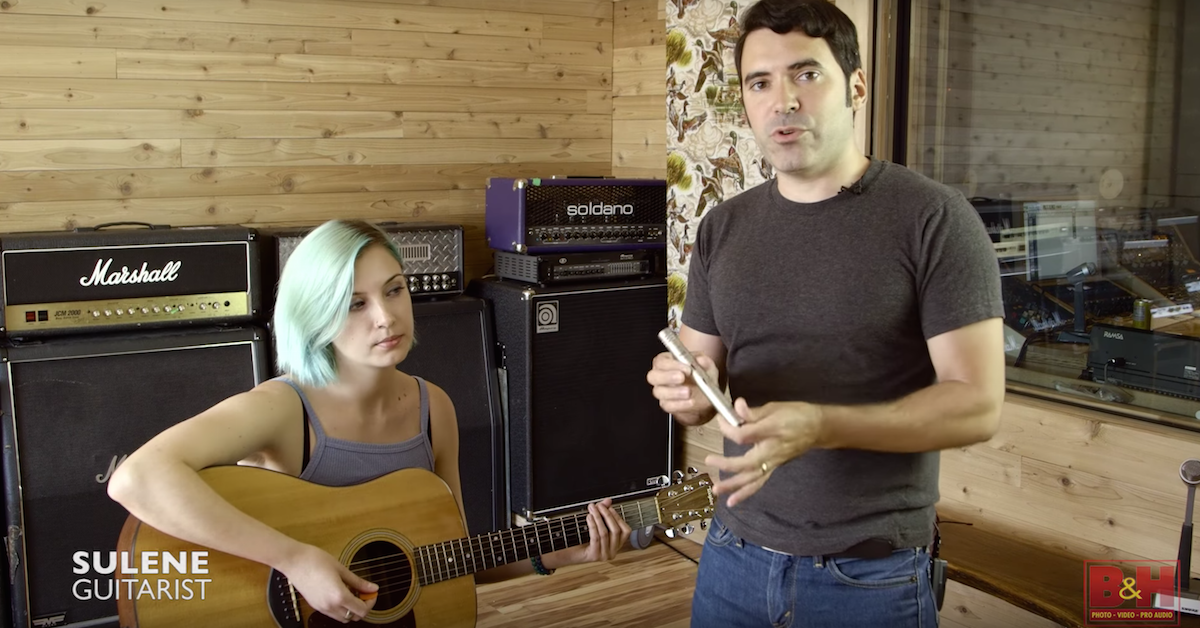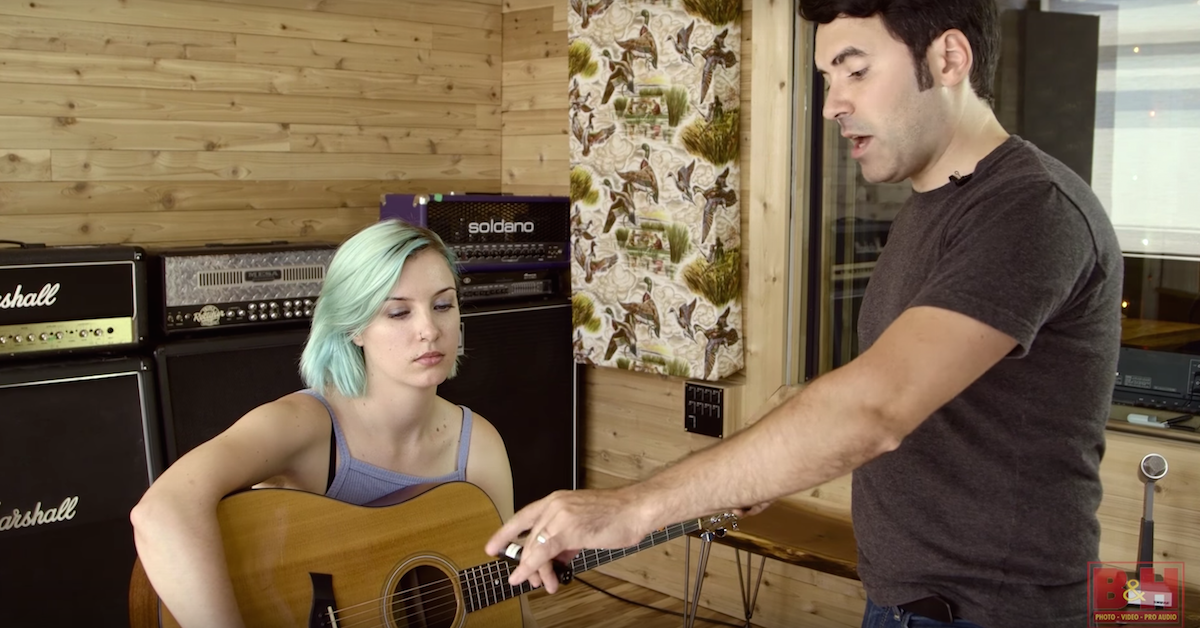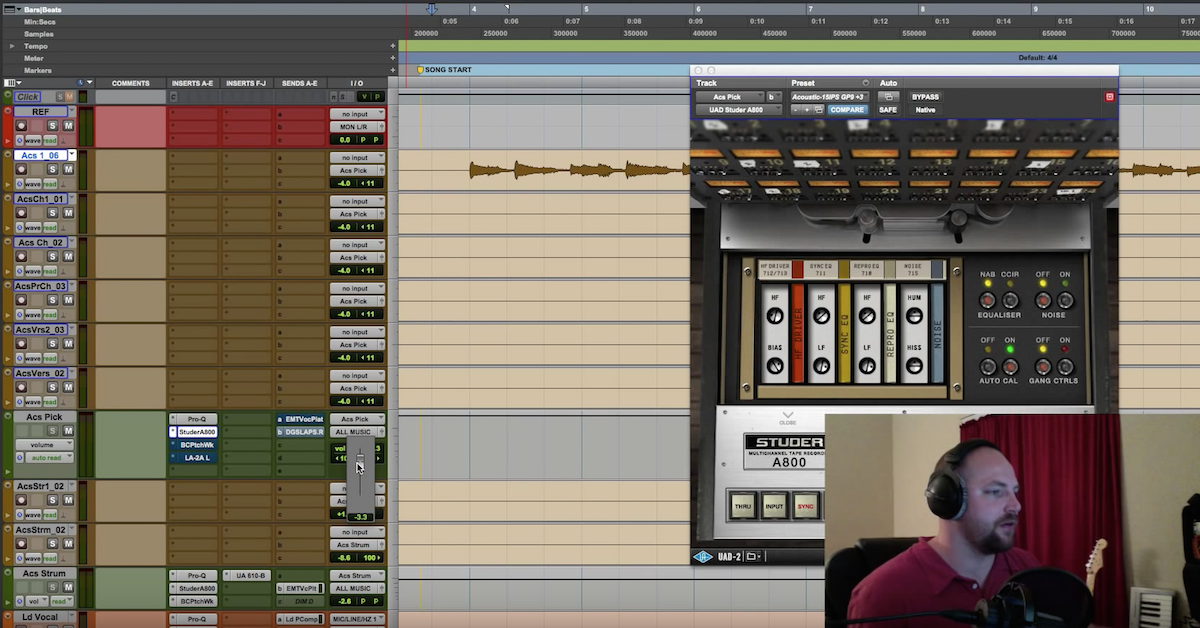How to Record Acoustic Guitar and Vocals at the Same Time
Article Content
Anyone who has mixed a song will know that mixing is easier when each track is recorded individually. Because of this, most recording engineers will want to track each instrument or vocal part independently when recording a band. This works fine if you play lead guitar, but for some performers, it presents a major problem.
Take a singer/songwriter for example. Most of their musical life is spent singing and playing the guitar at the same time, but then suddenly you expect them to separate these two activities and give you the same performance? It should come as no surprise then, if the results are less than stellar.
Rather than making life more difficult for the performer, sometimes you have to make some sacrifices on the recording end in order to capture the best performance. The question is, how do you go about capturing both the guitar and the voice at the same time without making the recording sound unnatural? Here are a few options to consider.
1. One Mono Mic
The simplest option (or so it would seem) is to use one mic and find the perfect spot for it. This is the way it was done on a lot of old recordings, and if you’re looking to create a vintage feel, using a single mic can be a useful option. Of course, finding the perfect spot is easier said than done, so you should be prepared for some trial and error if you want to use this technique.
With a single microphone, you’ll most likely want to position the mic closer to the singer’s mouth to emphasize the vocal performance. This will lead to a guitar that sounds somewhat distant in the mix, compared to what you’ll get with the other methods mentioned here. Still, for a demo or a recording with a more live feel, this can be a good method to work with.
2. Two Mono Mics
If you want more control over the sound of each source, and you’re not concerned about stereo recording, using two mono mics is a good option. There are many variations on this technique, so let’s focus on three basic techniques that you can play with to find your ideal sound.
The first is to use a dynamic mic like a Shure SM7B on the vocals and some sort of condenser mic on the guitar.
Tracking vocals through a dynamic mic might not be the best choice for every genre, but for something like rock music, where many singers track their vocals through a dynamic mic anyway, even when a condensor is an option, this method gives you a pretty well isolated vocal track to work with. Heck, while we’re at it, why not try out an SM57 on the guitar as well? This might not sound too convincing on its own, but sometimes in the context of a larger mix, a single dynamic mic on the acoustic guitar is all you need.
The second method is to use two cardioid or hypercardioid condensers.
Small diaphragm condensers will work well for this, as they tend to have good off-axis response, but sometimes a large diaphragm condenser will give you a better sound for vocals. The mic positioning with this method will likely change with each person and each song you record, so it will usually take a few attempts to find the perfect position for both mics. Some recording engineers like to have the two mics right next to each other, pointing in opposite directions, while others are happy with mics that are placed farther apart. Whichever setup you choose, the key is to keep the front of each mic pointed at the source you want to capture, while pointing the back (the “null” of the mic) towards the source you want to reject. Using two condensor mics won’t give you as much separation as the other mic techniques mentioned here, but with good mic placement, you should be able to get a nice balanced sound without too much off-axis weirdness.
A third method is to use two mics with figure 8 pickup patterns. Since figure 8 mics tend to have strong null points, you can use the null to your advantage by pointing that part of the mic towards the source you want to reject. You can use a similar setup to the one mentioned above for cardioid condensers, but with figure 8 mics, you’ll get more separation between the vocal and guitar tracks.
3. One Vocal Mic + Stereo Pair on Guitar
If your final product will be a sparser recording, you may want the acoustic guitar to fill up more space in the mix. This is where stereo acoustic guitar recording techniques come in handy.
A spaced pair of cardioid pattern condenser mics on the guitar often works well, as you can pan the left and right guitar mics nice and wide while focusing the vocal mic right down the middle. However, if the guitar is the only instrument in the mix, the spaced pair can sometimes create an off balance feel to the overall sound. If this is a problem, then an XY or ORTF stereo mic setup will give you a more focused but narrower guitar sound.
4. One Vocal Mic + Mid-Side Pair on Guitar
Another interesting option to try is a single mic for the vocals and a mid-side pair for the guitar.
The mid-side pair on the guitar gives you more control over the stereo image in the mix, and the single vocal mic gives you a focused vocal track that you can pan right down the middle of the mix.
This method can be a good option if you don’t want the mix to be too wide, but still want to add some stereo interest.
Conclusion
Multi-mic setups will give you the most dynamic sound for a guitar/voice recording, but when you’re working with multiple mics on the same source, it’s always important to keep phase coherence in mind, both when recording and when mixing. Always check your mics in mono when setting up a stereo recording and when working on the mix. It’s also a good idea to record each mic to its own track in your DAW so you can make micro-adjustments to the timing if necessary to fix the phase alignment of the tracks.
In the end, more mics usually means more work, but if you’re patient enough to get the placement right, using two or three mics will result in a richer and more rewarding sound.





